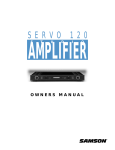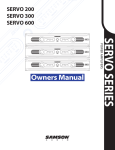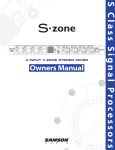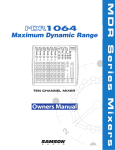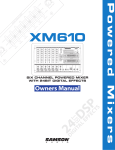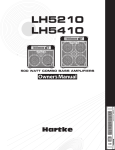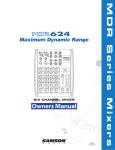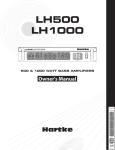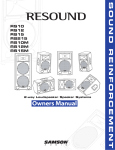Download Samson Power Amplifiers Specifications
Transcript
120 WATT STEREO POWER AMPLIFIER Safety Instructions/Consignes de sécurité/Sicherheitsvorkehrungen/Instrucciones de seguridad WARNING: To reduce the risk of fire or electric shock, do not expose this unit to rain or moisture. To reduce the hazard of electrical shock, do not remove cover or back. No user serviceable parts inside. Please refer all servicing to qualified personnel.The lightning flash with an arrowhead symbol within an equilateral triangle, is intended to alert the user to the presence of uninsulated "dangerous voltage" within the products enclosure that may be of sufficient magnitude to constitute a risk of electric shock to persons. The exclamation point within an equilateral triangle is intended to alert the user to the presence of important operating and maintenance (servicing) instructions in the literature accompanying the product. Important Safety Instructions 1. Please read all instructions before operating the unit. 2. Keep these instructions for future reference. 3. Please heed all safety warnings. 4. Follow manufacturers instructions. 5. Do not use this unit near water or moisture. 6. Clean only with a damp cloth. 7. Do not block any of the ventilation openings. Install in accordance with the manufacturers instructions. 8. Do not install near any heat sources such as radiators, heat registers, stoves, or other apparatus (including amplifiers) that produce heat. 9. Do not defeat the safety purpose of the polarized or grounding-type plug. A polarized plug has two blades with one wider than the other. A grounding type plug has two blades and a third grounding prong. The wide blade or third prong is provided for your safety. When the provided plug does not fit your outlet, consult an electrician for replacement of the obsolete outlet. 10. Protect the power cord from being walked on and pinched particularly at plugs, convenience receptacles and at the point at which they exit from the unit. 11. Only use attachments/accessories specified by the manufacturer. 12 Us only with the cart, stand, tripod, bracket, or table specified by the manufacturer, or sold with the apparatus. When cart is uses, use caution when moving the cart/apparatus combination to avoid injury from tip-over. 13 Unplug this unit during lightning storms or when unused for long periods of time. 12. Refer all servicing to qualified personnel. Servicing is required when the unit has been damaged in any way, such as power supply cord or plug damage, or if liquid has been spilled or objects have fallen into the unit, the unit has been exposed to rain or moisture, does not operate normally, or has been dropped. ATTENTION: Pour éviter tout risque d’électrocution ou d’incendie, ne pas exposer cet appareil à la pluie ou à l’humidité. Pour éviter tout risque d’électrocution, ne pas ôter le couvercle ou le dos du boîtier. Cet appareil ne contient aucune pièce remplaçable par l'utilisateur. Confiez toutes les réparations à un personnel qualifié. Le signe avec un éclair dans un triangle prévient l’utilisateur de la présence d’une tension dangereuse et non isolée dans l’appareil. Cette tension constitue un risque d’électrocution. Le signe avec un point d’exclamation dans un triangle prévient l’utilisateur d’instructions importantes relatives à l’utilisation et à la maintenance du produit. Consignes de sécurité importantes 1. Veuillez lire toutes les instructions avant d’utiliser l’appareil. 2. Conserver ces instructions pour toute lecture ultérieure. 3. Lisez avec attention toutes les consignes de sécurité. 4. Suivez les instructions du fabricant. 5. Ne pas utiliser cet appareil près d’une source liquide ou dans un lieu humide. 6. Nettoyez l’appareil uniquement avec un tissu humide. 7. Veillez à ne pas obstruer les fentes prévues pour la ventilation de l’appareil. Installez l’appareil selon les instructions du fabricant. 8. Ne pas installer près d’une source de chaleur (radiateurs, etc.) ou de tout équipement susceptible de générer de la chaleur (amplificateurs de puissance par exemple). 9. Ne pas retirer la terre du cordon secteur ou de la prise murale. Les fiches canadiennes avec polarisation (avec une lame plus large) ne doivent pas être modifiées. Si votre prise murale ne correspond pas au modèle fourni, consultez votre électricien. 10. Protégez le cordon secteur contre tous les dommages possibles (pincement, tension, torsion,, etc.). Veillez à ce que le cordon secteur soit libre, en particulier à sa sortie du boîtier. 11. Déconnectez l’appareil du secteur en présence d’orage ou lors de périodes d’inutilisation prolongées. 12. Consultez un service de réparation qualifié pour tout dysfonctionnement (dommage sur le cordon secteur, baisse de performances, exposition à la pluie, projection liquide dans l’appareil, introduction d’un objet dans le boîtier, etc.). ACHTUNG: Um die Gefahr eines Brandes oder Stromschlags zu verringern, sollten Sie dieses Gerät weder Regen noch Feuchtigkeit aussetzen.Um die Gefahr eines Stromschlags zu verringern, sollten Sie weder Deckel noch Rückwand des Geräts entfernen. Im Innern befinden sich keine Teile, die vom Anwender gewartet werden können. Überlassen Sie die Wartung qualifiziertem Fachpersonal.Der Blitz mit Pfeilspitze im gleichseitigen Dreieck soll den Anwender vor nichtisolierter “gefährlicher Spannung” im Geräteinnern warnen. Diese Spannung kann so hoch sein, dass die Gefahr eines Stromschlags besteht. Das Ausrufezeichen im gleichseitigen Dreieck soll den Anwender auf wichtige Bedienungs- und Wartungsanleitungen aufmerksam machen, die im mitgelieferten Informationsmaterial näher beschrieben werden. Wichtige Sicherheitsvorkehrungen 1. Lesen Sie alle Anleitungen, bevor Sie das Gerät in Betrieb nehmen. 2. Bewahren Sie diese Anleitungen für den späteren Gebrauch gut auf. PRECAUCION: Para reducir el riesgo de incendios o descargas, no permita que este aparato quede expuesto a la lluvia o la humedad. Para reducir el riesgo de descarga eléctrica, nunca quite la tapa ni el chasis. Dentro del aparato no hay piezas susceptibles de ser reparadas por el usuario. Dirija cualquier reparación al servicio técnico oficial. El símbolo del relámpago dentro del triángulo equilátero pretende advertir al usuario de la presencia de “voltajes peligrosos” no aislados dentro de la carcasa del producto, que pueden ser de la magnitud suficiente como para constituir un riesgo de descarga eléctrica a las personas. El símbolo de exclamación dentro del triángulo equilátero quiere advertirle de la existencia de importantes instrucciones de manejo y mantenimiento (reparaciones) en los documentos que se adjuntan con este aparato. Instrucciones importantes de seguridad 1. Lea todo este manual de instrucciones antes de comenzar a usar la unidad. 2. Conserve estas instrucciones para cualquier consulta en el futuro. 3. 4. 5. 6. 7. 3. 4. 5. 6. 7. 8. 9. 10. 11. 12. Bitte treffen Sie alle beschriebenen Sicherheitsvorkehrungen. Befolgen Sie die Anleitungen des Herstellers. Benutzen Sie das Gerät nicht in der Nähe von Wasser oder Feuchtigkeit. Verwenden Sie zur Reinigung des Geräts nur ein feuchtes Tuch. Blockieren Sie keine Belüftungsöffnungen. Nehmen Sie den Einbau des Geräts nur entsprechend den Anweisungen des Herstellers vor. Bauen Sie das Gerät nicht in der Nähe von Wärmequellen wie Heizkörpern, Wärmeklappen, Öfen oder anderen Geräten (inklusive Verstärkern) ein, die Hitze erzeugen. Setzen Sie die Sicherheitsfunktion des polarisierten oder geerdeten Steckers nicht außer Kraft. Ein polarisierter Stecker hat zwei flache, unterschiedlich breite Pole. Ein geerdeter Stecker hat zwei flache Pole und einen dritten Erdungsstift. Der breitere Pol oder der dritte Stift dient Ihrer Sicherheit. Wenn der vorhandene Stecker nicht in Ihre Steckdose passt, lassen Sie die veraltete Steckdose von einem Elektriker ersetzen. Schützen Sie das Netzkabel dahingehend, dass niemand darüber laufen und es nicht geknickt werden kann. Achten Sie hierbei besonders auf Netzstecker, Mehrfachsteckdosen und den Kabelanschluss am Gerät. Ziehen Sie den Netzstecker des Geräts bei Gewittern oder längeren Betriebspausen aus der Steckdose. Überlassen Sie die Wartung qualifiziertem Fachpersonal. Eine Wartung ist notwendig, wenn das Gerät auf irgendeine Weise, beispielsweise am Kabel oder Netzstecker beschädigt wurde, oder wenn Flüssigkeiten oder Objekte in das Gerät gelangt sind, es Regen oder Feuchtigkeit ausgesetzt war, nicht mehr wie gewohnt betrieben werden kann oder fallen gelassen wurde. 8. 9. 10. 11. 12. Cumpla con todo lo indicado en las precauciones de seguridad. Observe y siga todas las instrucciones del fabricante. Nunca utilice este aparato cerca del agua o en lugares húmedos. Limpie este aparato solo con un trapo suave y ligeramente humedecido. No bloquee ninguna de las aberturas de ventilación. Instale este aparato de acuerdo a las instrucciones del fabricante. No instale este aparato cerca de fuentes de calor como radiadores, calentadores, hornos u otros aparatos (incluyendo amplificadores) que produzcan calor. No anule el sistema de seguridad del enchufe de tipo polarizado o con toma de tierra. Un enchufe polarizado tiene dos bornes, uno más ancho que el otro. Uno con toma de tierra tiene dos bornes normales y un tercero para la conexión a tierra. El borne ancho o el tercero se incluyen como medida de seguridad. Cuando el enchufe no encaje en su salida de corriente, llame a un electricista para que le cambie su salida anticuada. Evite que el cable de corriente quede en una posición en la que pueda ser pisado o aplastado, especialmente en los enchufes, receptáculos y en el punto en el que salen de la unidad. Desconecte de la corriente este aparato durante las tormentas eléctricas o cuando no lo vaya a usar durante un periodo de tiempo largo. Dirija cualquier posible reparación solo al servicio técnico oficial. Deberá hacer que su aparato sea reparado cuando esté dañado de alguna forma, como si el cable de corriente o el enchufe están dañados, o si se han derramado líquidos o se ha introducido algún objeto dentro de la unidad, si esta ha quedado expuesta a la lluvia o la humedad, si no funciona normalmente o si ha caído al suelo. Table of Contents Introduction 4 Servo 120a Features 5 Guided Tour 6 6 7 Front Panel Rear Panel Setting Up and Using the Servo 120a Amplifier 8 The Servo 120a Protection Circuitry 9 Bridge Mode 10 Appendix A: Linearity vs. Frequency Sweep 11 Appendix B: Power Output vs. THD 12 Specifications 13 Copyright 2004, Samson Technologies Corp. Printed December, 2004 Samson Technologies Corp. 575 Underhill Blvd. P.O. Box 9031 Syosset, NY 11791-9031 Phone: 1-800-3-SAMSON (1-800-372-6766) Fax: 516-364-3888 Introduction Congratulations on purchasing the Samson Servo 120a Power Amplifier! Although designed for easy operation, we suggest you first take some time to go through these pages so you can fully understand how we’ve implemented a number of unique features. The Servo 120a is a single rack-space stereo power amplifier which is optimized for use in both professional and project recording studio environments as well as for live performance. It delivers 60 watts of power per channel into 4 ohms (or, in Bridge mode, 120 watts into 8-ohms) over the full frequency spectrum, from 3 Hz to 65 kHz. Both balanced 1/4" TRS and unbalanced RCA-type input connectors are provided, along with 5-way binding post output connectors. Front-panel controls and displays include a power switch, independent left- and rightchannel input level controls, ten-segment LED meters, a Protection LED, and a convenient headphone jack and speaker on/off switch for private cue monitoring. Suggested applications for the Servo120 include: • Amplification for nearfield monitors or cue headphones in both professional and project studios - Its superb audio specs and whisper-quiet performance (its convection cooling design means there is no fan), along with its unique front-panel speaker on-off switch and dedicated headphone jack, make the Servo 120a the perfect complement to any recording studio. • Home Theatre applications - The power and flexibility offered by the Servo 120a (it can be used either as a 60 watt stereo amplifier, or, in bridge mode, as a 120 watt monophonic amp) makes it the perfect addition to any home theatre, in conjunction with any DVD player or other surround sound system. For example, use it in stereo mode to drive your main front left/right speakers, using your home stereo to drive the rear satellite speakers—or use the Servo 120a in Bridge mode to drive your center channel or subwoofer with power galore. • As an extension to a home hi-fi system - The Servo 120a boasts professional specs which far exceed that of most consumer products. For a real “studio” experience in your own home, try connecting your home hi-fi amplifier’s auxiliary outputs to the Servo 120a’s inputs (thus using your hi-fi amp as a preamplifier) and then connect your existing speakers to the Servo 120a’s outputs. If you fall in love with the sound (as we’re sure you will), you might want to substitute a professional pre-amplifier for your existing hi-fi amp—and, from there, you may well end up graduating to higher-level speakers. High quality sound is addicting— don’t say we didn’t warn you! • Powering public address systems in permanent installations - The Servo 120a can be used to effectively drive PA speakers in installations such as classrooms and corporate conference rooms. • Onstage monitoring - In small and medium-sized onstage areas (such as in clubs, lounges, etc.), the Servo 120a can be used to drive stage monitors, allowing the performers to hear themselves without having to rely on onstage equipment amplification. • MIDI rack monitoring - Taking only a single rack space, MIDI musicians can easily incorporate the Servo 120a into their existing rack of gear. Combined with a pair of high quality stage or studio speakers, this makes for an excellent monitoring system that can accurately reproduce the broad range of frequencies typically output by devices such as synthesizers, samplers, and digital audio workstations. In these pages, you’ll find a detailed description of the many features of the Servo 120a Power Amplifier, as well as a guided tour through its front and rear panels, step-by-step instructions for its setup and use, reference appendices, and full specifications. You’ll also find a warranty card enclosed—please don’t forget to fill it out and mail it in so that you can receive online technical support and so we can send you updated information about these and other Samson products in the future. SPECIAL NOTE: Should your unit ever require servicing, a Return Authorization number (RA) is necessary. Without this number, the unit will not be accepted. Please call Samson at 1-800-372-6766 for a Return Authorization number prior to shipping your unit. Please retain the original packing materials and, if possible, return the unit in its original carton and packing materials. 4 Servo 120a Features The Samson Servo 120a Power Amplifier utilizes the latest technology in professional power amplifier design. Here are some of its main features: • Power to spare - Each channel delivers 60 watts of power into 4 ohms (or, in Bridge mode, 120 watts into 8 ohms). • Clean, crisp sound - Impressive audio specifications such as .01% THD, S/N of 105 dB, crosstalk of 75 dB, and frequency response of 3 Hz to 65 kHz guarantee ultra-clean sound quality in any live or recording environment. • Independent input level controls for each channel with 41-position detents. • Ten-segment LED meters for each channel continuously display power output levels and allow you to correct for overloading (clipping) conditions. • Front-panel Protection LED shows you at a glance overheating or faulty wiring conditions. • Innovative front-panel Speaker on/off switch and dedicated headphone jack enables private cue monitoring of the input signal. • Both electronically balanced 1/4" TRS and unbalanced RCA-type input connector jacks are provided along with 5-way binding post output connectors. • Convection cooling (no fan) makes for whisper-quiet operation even in critical listening environments such as recording studios. • Unique bipolar circuit design that continuously keeps DC output during idling at or near 0 volts (thus keeping idle speakers at their 0 point). This serves to minimize heat overload problems by effectively preventing the Servo 120a from applying power when unnecessary. • Protection relay circuitry (linked to the DC offset circuitry) that prevents “thumps” when powering on or off. This means that you can use the Servo 120a with a single power strip into which a mixer or other audio devices are connected, without danger of damage to connected speakers. • Toroidal transformer power supply. • Rugged construction (an all-steel chassis with a titanium finish and a lightweight anodized aluminum heat sink) makes the Servo 120a eminently roadworthy. • Flexible design allows the Servo 120a to be used free-standing or, with the use of included rack ears, mounted in any standard 19" rack (taking just a single rack space). • Three-year warranty. • Last but certainly not least, value. The Samson Servo 120a has been designed from the ground up to deliver excellent yet affordable sound quality. 5 Guided Tour - Front Panel � � � � � � � � � � � � � � �� 1: Channel input level controls - These 41-position detented knobs allow you to adjust the input level of the signal arriving at the rear-panel input jacks (see #4 and #5 on the following page). At their fully counterclockwise position, the signal is attenuated by 70 dB (essentially completely off ). At their fully clockwise position, the signal is at unity gain (that is, no attenuation). When +4 dBu of signal arrives at the input jacks and the Channel input level controls are set to their fully clockwise “0 dB” position, the Servo 120a delivers full power output. 2: LED meters - These ten-segment LED meters continuously monitor the power output level for the corresponding channel. For example, when the -8dB segment is lit, the amplifier is operating at 20% of it's maximum power. When the -4dB segment is lit, 40% of it's maximim power, 0dB segment, 60% power, +2 segment lit, 80% power, +4 segment lit, 100% power. When the PEAK LED lights, the amplifier is producing a distorted (clipped) output signal For the best signal-to-noise ratio, the PEAK segment should light occasionally during maximum levels: If it lights frequently, the amplifier may be overloadedTry turning down the input level controls. If the amplifier now delivers too low an output level for your application, consider using Bridge mode (see the “Bridge Mode” section on page 10 in this manual for more information). 3: Headphone jack - Connect any standard stereo headphones to this jack (via a standard 1/4" TRS plug) for private monitoring of the final output signal. NOTE: The Servo 120a speaker outputs are not automatically muted when headphones are inserted into the Headphone jack—to monitor incoming signal in privacy, press the Speaker on/off switch (see #7 below) so that it is out (in its “up” position)—the Speaker on/off LED will go off. The built-in Servo 120a headphone amplifier delivers 400 mW into 100 ohms. 4: Power LED - Lit whenever the Servo 120a is powered on. 5: Power switch - Use this to power the Servo120 on or off. 6: Speaker on/off LED - Lights when the Speaker on/off switch (see #6 above) is pressed in and the Servo 120a is delivering signal to its rear panel output terminals (see #7 on the following page). 7: Speaker on/off switch - When pressed in (the normal position), the Servo 120a delivers signal to its rear panel output terminals (see #3 on the following page). When this switch is out (in its “up” position), outgoing signal is muted, allowing personal monitoring of incoming signal through connected headphones (see #3 above). 8: Idle LED - Lit when there is signal present at the Servo 120a's input. 9: Protect LED - When illuminated, the Servo 120a is in protection mode and the outputs temporarily shut off. 10: Peak LED - Lit whenever the Servo 120a is producing a clipped output signal. 6 Guided Tour - Rear Panel � � � � � � � � � 1: AC Input - Connect the supplied standard 3-pin “IEC” plug here. 2: Fuse Holder - Insert a 2.5 amp, SLO-BLO 125 volt fuse here for 115 volt operation, or a 1.5 amp, SLO-BLO 250 volt fuse for 230 volt operation. WARNING: Fuses should only be replaced with the power cord disconnected. 3: 5-way Binding Post Output Connectors - Use these to connect each channel of the Servo 120a to loudspeakers. Be sure to connect the loudspeaker correctly, with the red (+) terminal normally connected to the positive input of the speaker and the black (ground) terminal normally connected to the negative input of the speaker. See the “Bridge Mode” section on page 10 in this manual for speaker connection instructions when using the Servo 120a in Bridge mode. 4: Balanced Inputs* - Connect incoming signal to these electronically balanced 1/4" TRS (Tip/Ring/Sleeve) jacks, wired as follows: Tip hot, Ring cold, and Sleeve ground. Use balanced three-conductor cabling and TRS plugs wherever possible (unbalanced two-conductor plugs can also be inserted into these inputs, but you’ll get better signal quality and less outside noise and hum if you use balanced lines). Stereo signals should be connected to both the left and right input jacks; when operating the Servo 120a in Bridge mode, use the left input jack only (see page 10 in this manual for more information). The Servo 120a accepts input levels of any strength but needs at least +4 dBu to achieve maximum power. 5: Unbalanced Inputs* - Connect incoming signal to these unbalanced RCA-type jacks. Stereo signals should be connected to both the left and right input jacks; when using the Servo 120a in Bridge mode, use the left input jack only (see page 10 in this manual for more information). The Servo 120a accepts input levels of any strength but needs at least -10 dBv to achieve maximum power. 6: Bridge switch - For normal operation, place this switch at its right (“STEREO”) position. When placed at its left (“BRIDGE”) position, the two amplifier sections (the left and right channels) are bridged, providing full 120 watt power into a single output. For more information, see the “Bridge Mode” section on page 10 in this manual. WARNING: Due to the extremely high power output of the Servo 120a when used in Bridge mode, be sure to use only 8 ohm loudspeakers sufficiently rated to handle the resultant wattage. * If required, both the balanced and unbalanced inputs can be used simultaneously. 7 Setting Up and Using the Servo 120a Power Amplifier Setting up your Servo 120a is a simple procedure which takes only a few minutes: 1. Remove all packing materials (save them in case of need for future service) and decide where the amplifier is to be physically placed—it can be used free-standing or mounted in a standard 19" rack, requiring only one rack space. When installed, make sure that there is good ventilation around the entire unit (we recommend using spacer panels, especially if multiple amplifiers are used in a rack. Before rack-mounting, use a Philips screwdriver to remove the Servo 120a’s feet. Bridge switch Output connectors Input connectors 2. Set the rear panel Bridge switch as desired (see page 10 in this manual). 3. Make the speaker connections, using the 5-way binding post output connectors on the rear panel. It is never a good idea to power up any amplifier that is not connected to loudspeakers. In normal operation, any loudspeakers with a minimum impedance load of 4 ohms (that is, 4 ohms or greater) can be used; however, in Bridge mode, 8 ohm speakers must be used. Be sure to connect the loudspeaker correctly. In normal mode, connect them with the red (+) terminal connected to the positive input of the speaker and the black (ground) terminal connected to the negative input of the speaker. See page 10 in this manual for connection instructions when using the Servo 120a in Bridge mode. 4. Next, make the signal input connections, using the electronically balanced 1/4" and/or the unbalanced RCA-type input connectors on the rear panel (if operating the Servo 120a in Bridge mode, use the left input only—see page 7 in this manual). If your mixer or crossover network has balanced outputs, use the Servo 120a’s electronically balanced inputs (unbalanced twoconductor plugs can also be inserted into these inputs, but you’ll get better signal quality and less outside noise and hum if you use balanced lines). 5. On the front panel of the Servo 120a, turn both Channel input controls fully counterclockwise. Then connect the supplied 3-pin “IEC” cable to the rear panel IEC connector and to any grounded AC socket. Because of the relay protection circuitry built into the Servo 120a, you can even plug it into the same power strip that other audio devices (such as a mixing console) are connected to. You can then turn on all devices at once with the single power strip on-off switch, with no danger of damaging connected speakers by generating “thumps.” Channel Input control Protection LED Ten-segment LED meters Headphone jack and Speaker on/off switch 6. Press the front panel Speaker on/off switch (so that it is in, in its “down” position) and then press the front panel Power switch in order to turn on the Servo 120a. The Power LED will light and the Protection LED will go on. After approximately five seconds, the Protection LED will go off and the Speaker LED (in the Speaker on/off switch) will light instead (you’ll hear a click when this occurs). 7. Apply an input signal to the Servo 120a at or about +4 dBu (if sending signal from a mixer, drive the output meters at approximately 0 vu). While the input signal is present, slowly raise the Channel Input controls until the desired sound level is achieved. The ten-segment LED meters next to each Channel input control will show you the continuous power output of the Servo 120a as signal is being passed. For the best signal-to-noise ratio, the Servo 120a should normally be run with the Channel Input controls at or near maximum and the right-most (+4 dB / 100%) segment should light occasionally (but not frequently) during peak levels. If you are using a mixer that has a master output level control (sometimes called “Control Room level”), use it to attenuate the signal as necessary to achieve the desired speaker level. 8. You can monitor the output signal in privacy by connecting a pair of headphones to the front panel headphone jack and pressing the Speaker on/off switch so that it is out (in its “up” position), at which time the Speaker LED will go off. WARNING: Because the Servo 120a is capable of generating extremely high headphone signal levels, always start with the Channel Input knobs turned down and then slowly raise them to the desired level. If you encounter difficulty with any aspect of setting up or using your Servo 120a, you can call Samson Technical Support (1-800-372-6766) between 9 AM and 5 PM EST. 88 The Servo 120a Protection Circuitry As noted in the “Guided Tour” section of this manual, the Servo 120a's front panel Protection LED indicates the activity of the relay speaker connection circuitry. When the Protection LED is lit, this circuitry is inactive, and all connected speakers are muted (provided with 0 volts DC), thus protecting them and preventing any audible “thump” from occurring. The following conditions will cause the Protection LED to go on: • Initial power-up: For approximately five seconds after initial power-up, the relay speaker connection circuitry is deactivated and the speaker output is muted. If everything is operating normally, you will hear an audible click at the conclusion of this brief period, as the circuitry is activated and the Servo 120a begins delivering signal to connected speakers (at which point the Speaker LED will light if the Speaker on/off switch is in its “in” position). It is normal for the Protection LED to fade gradually after the amplifier is powered off. WARNING: If the Protection LED fails to go out (and you fail to hear the accompanying audible click) approximately five seconds after power-up, turn the Servo 120a off immediately and check all external devices and wiring for possible shorts or other defects. • Overheating: A temperature sensing device in the Servo 120a will cause the relay speaker connection circuitry to be activated (and the Protection LED to go on) whenever the operating temperature of the unit rises above a safe level. To guard against this problem, make sure the Servo 120a receives adequate ventilation on all sides (see page 8 for more information); in extreme environmental conditions, you may also want to consider the use of cooling fans. • Severe overcurrent conditions: This occurs whenever the signal being output from the Servo 120a rises to a level above 20% THD (Total Harmonic Distortion). • Shorted speaker cables: This will occur if, due to faulty wiring, the hot and ground signals being output by the Servo 120a short to one another. • Output impedance drops below 2 ohms: This can occur if the Servo 120a is connected to inappropriate speaker systems (see the “Setting Up and Using the Servo 120a” section in this manual for more information). • DC voltage detected at speaker output: The most likely cause of this is an internal failure. In general, any time the Protection LED lights up (other than during the approximately five seconds following initial power-up), there is reason to be concerned. If this occurs, turn the Servo 120a off immediately and carefully check all wiring and external devices in order to locate and correct the condition that caused the LED to light up in the first place. 9 Bridge Mode The Servo 120a provides a rear-panel switch that allows it to be used in a Bridge mode. When this switch is placed in the “RIGHT” (Stereo) position, the Servo 120a functions as a true stereo amplifier, where both of the two independent amplifier channels (left and right) can receive different input signals and produce independent output signals. However, when the switch is placed in the “LEFT” (Bridge) position, both amplifier channels process only the signal present at the left input, thus producing a single output signal with a true 120 watt output (into 8 ohms). WARNING: Bridge mode is to be used only when the Servo 120a is connected to an 8 ohm speaker load. Use of Bridge mode with speaker loads of 4 ohms or less can result in severe damage to the unit due to excessive heat and current and will void your warranty! INPUT LEFT(+) OUTPUT RIGHT(+) OUTPUT The illustration on the left shows how this works. In bridge mode, the polarity (phase) of the right output signal is reversed relative to that of the left output signal. Both channels then process the same signal, with the speaker load connected so that power is derived from both channels. The effective voltage swing seen by the load is thus doubled so that the power output is doubled. When using the Servo 120a in Bridge mode, be sure to connect each loudspeaker as shown in the illustration below (and as silkscreened on the rear panel), with the red (+) terminal of the left channel connected to the positive input of the speaker and the red (+) terminal of the right channel connected to the negative input of the speaker. Do not use the black (ground) output terminal of either channel (the speaker load must “float” away from the amplifier chassis). + - 10 Appendix A: Linearity vs. Frequency Sweep AUDIO PRECISION Servo 120a LEVEL (dBr) vs FREQ (Hz) 0dB ref 5.0000 4.0000 Ap 3.0000 2.0000 1.0000 0.0 -1.000 -2.000 -3.000 -4.000 -5.000 10 100 1k Linearity (0 dB Ref) vs. frequency sweep 10 Hz - 50 kHz 11 10k 50k Appendix B: Power Output vs. THD AUDIO PRECISION Servo 120a THD +N (%) & LEVEL (W) vs FREQ (Hz) Watts THD 1.000 80.000 Ap .9000 73.000 61.000 .8000 56.000 .7000 48.000 .6000 40.000 .5000 32.000 .4000 21.000 .3000 15.000 .2000 8.000 .1000 200.0u 20 100 1k 10k Power output (60 W) vs. Total Harmonic Distortion 12 50k 0.000 Specifications Rated Output Power, per channel (@ 1 kHz) Stereo mode 4 ohm, .<0.05% THD+N 4 ohm, 1% THD+N 8 ohm, <0.05% THD+N 8 ohm, 1% THD+N Bridge mode 8 ohm, .<0.05% THD+N 8 ohm, 1% THD+N 60 W 80 W 50 W 55 W 120 W 150 W Typical Distortion, per channel THD+N (80 kHz LPF @ 1 kHz, rated output power) IMD (SMPTE 4:1, 60 Hz & 7 kHz @ rated output power) .01% .03% Signal To Noise Ratio (22 Hz - 22 kHz bandwidth @ dB below rated output power) 10 Hz - 20 kHz +0, -0.5 dB 3 Hz - 65 kHz, +0, -3.0 dB Frequency Response Input Sensitivity 105 dB -10dBv on the RCA inputs, +4 dBu on the 1/4" inputs to achieve rated power. (Level control set to maximum) -75 dB, 1 kHz Crosstalk (adjacent channels) Output DC Offset Voltage ± 50 mV, DC Servo Controlled Headphone Output Level Dimensions 400 mW (into 100 Ω @ 1% THD+N) 17.5 in (w) x 11.5 (d) x 1.75 (h) 444 mm (w) x 292 (d) x 44 (h) 15.6 lbs • 7 kg Weight 13 Notes 14 Samson Technologies Corp. 575 Underhill Blvd. P.O. Box 9031 Syosset, NY 11791-9031 Phone: 1-800-3-SAMSON (1-800-372-6766) Fax: 516-364-3888 www.samsontech.com
















